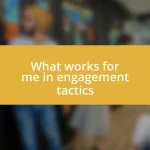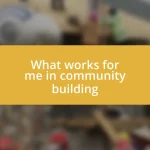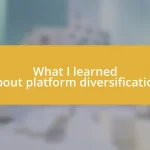Key takeaways:
- Defining a community vision involves fostering empathy, support, and open-mindedness, creating an emotional core that invites participation.
- Engaging the target audience through active listening, surveys, and informal interactions helps tailor initiatives that promote loyalty and connection.
- Measuring community growth requires both quantitative metrics and qualitative feedback, focusing on building relationships rather than just increasing numbers.
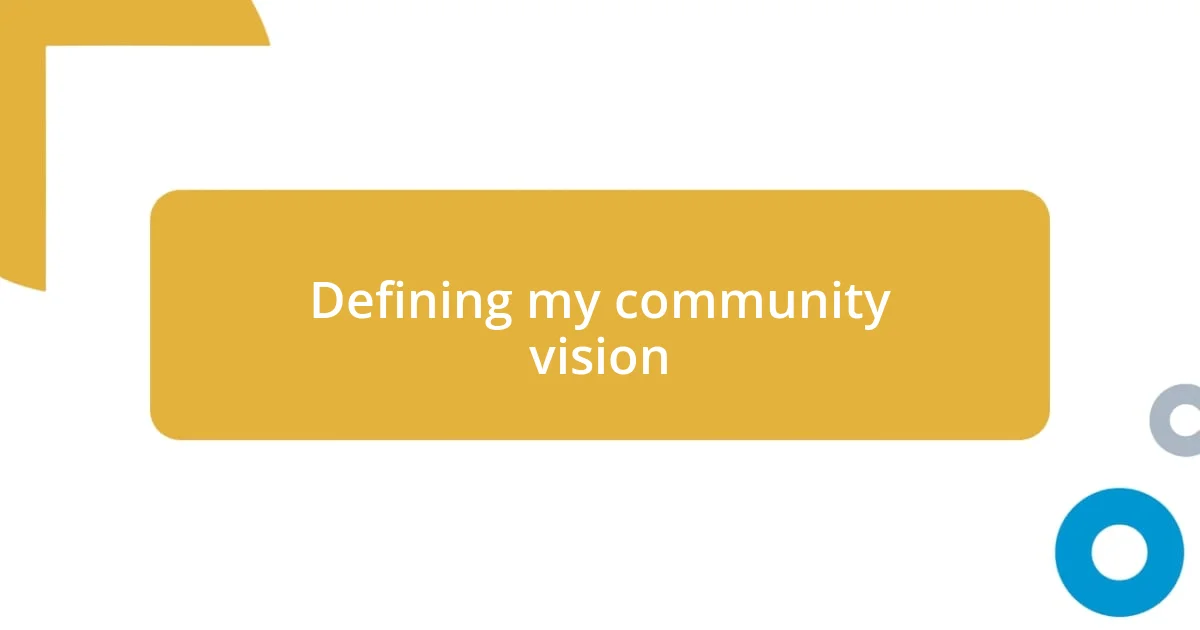
Defining my community vision
Defining my community vision started with a clear realization: I wanted to create a space where everyone felt valued and heard. I remember sitting in my favorite café, sipping coffee, and scribbling down ideas about what a supportive community looked like for me. I began to visualize a gathering of diverse voices, all contributing unique perspectives and experiences—doesn’t that just spark excitement?
One powerful moment that shaped this vision was a conversation I had with a long-time friend who opened up about feeling isolated despite being surrounded by people. This made me question: How can we foster genuine connections? I recognized that creating a vision was about more than just numbers or engagement metrics; it was about cultivating empathy and trust within the community.
As I continued to delve deeper, I found myself asking what values would guide our interactions. I envisioned a community where kindness, support, and open-mindedness weren’t just buzzwords but the foundation of every interaction. It was in defining these values that I discovered the emotional core of my vision, shaping not just an agenda, but a heartfelt invitation to join a collective journey.
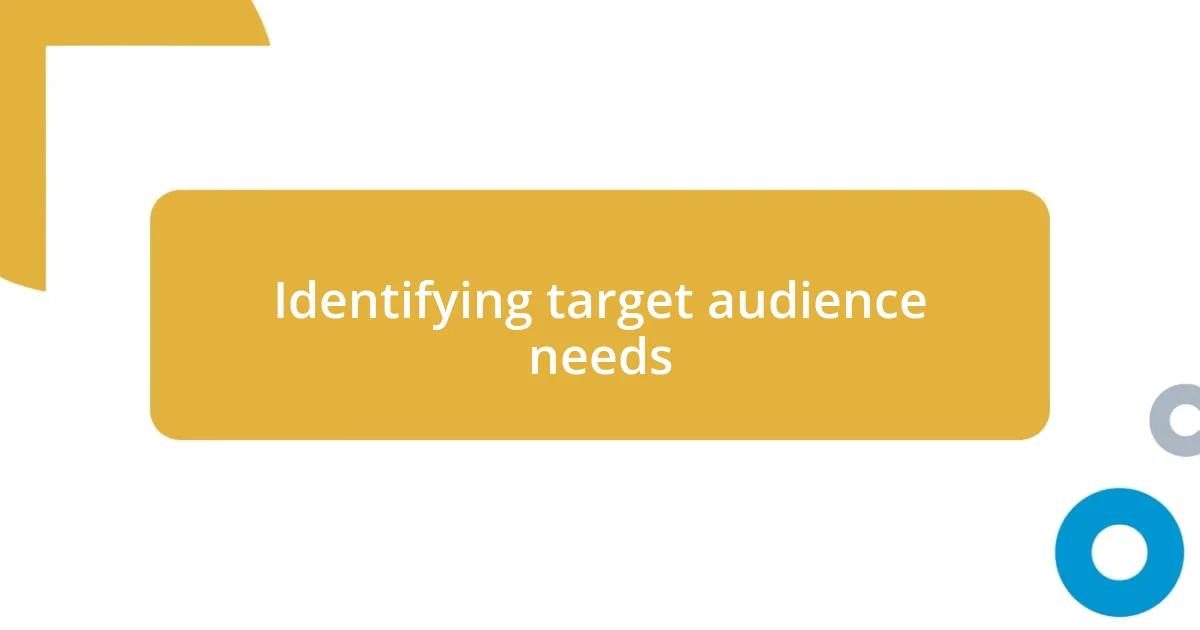
Identifying target audience needs
Identifying the needs of my target audience was a pivotal step in building my community. I began by actively engaging in conversations with potential members, asking what challenges they faced and what they were seeking in a supportive space. I remember one chat with a newcomer who candidly shared her frustration about not finding a safe outlet for her creative ideas. That revelation struck a chord; it opened my eyes to the importance of truly listening before making any assumptions.
To uncover the needs of my audience, I focused on the following strategies:
- Conducting surveys to gather insights.
- Hosting informal meet-ups to foster open dialogue.
- Observing interactions in similar communities to learn from their strengths and weaknesses.
- Creating a dedicated online space for feedback and suggestions.
- Analyzing engagement patterns on social media to identify interests.
By embracing these methods, I was able to cultivate a clearer understanding of what my community craved, leading to tailored initiatives that fostered loyalty and engagement.
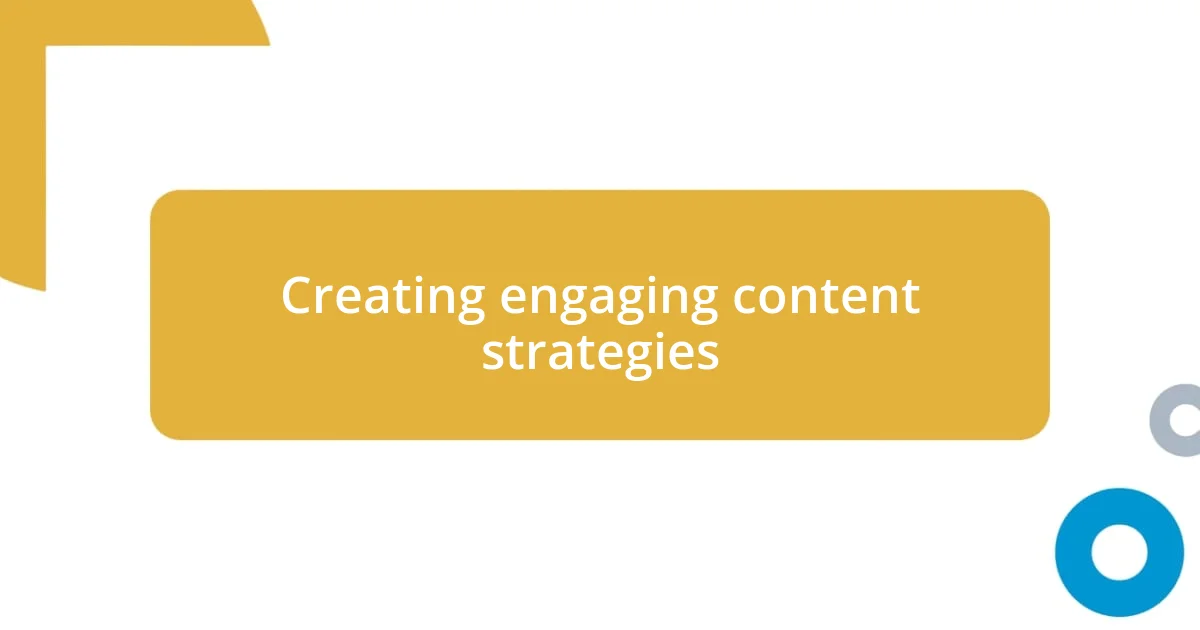
Creating engaging content strategies
Creating engaging content strategies is where the magic happens in community building. From my experience, storytelling has been one of the most powerful tools to connect with my audience. I recall sharing a personal journey about overcoming challenges in my own creative pursuits. It resonated with many, sparking conversations and perhaps even motivating others to share their stories. It’s fascinating how a simple anecdote can turn into a catalyst for deeper engagement.
Visual content also plays a pivotal role in attracting attention. I discovered that a well-placed infographic or an engaging video could convey complex ideas far more effectively than text alone. For instance, I once created a short video summarizing the core values of my community, which not only clarified our mission but also fostered a sense of belonging. Isn’t it amazing how visuals can evoke emotions and make information stick?
Finally, I learned that consistency is key. Regularly scheduled content, whether it’s weekly blog posts or daily social media updates, helps build anticipation within my community. I remember when I started a monthly Q&A session, and the response was overwhelming; people eagerly awaited the opportunity to participate, share their questions, and connect with one another. Building this rhythm has been essential in keeping the community engaged, making members feel involved and valued.
| Content Strategy | Description |
|---|---|
| Storytelling | Using personal anecdotes to create emotional connections. |
| Visual Content | Implementing infographics and videos for clarity. |
| Consistency | Regular updates to foster anticipation and involvement. |
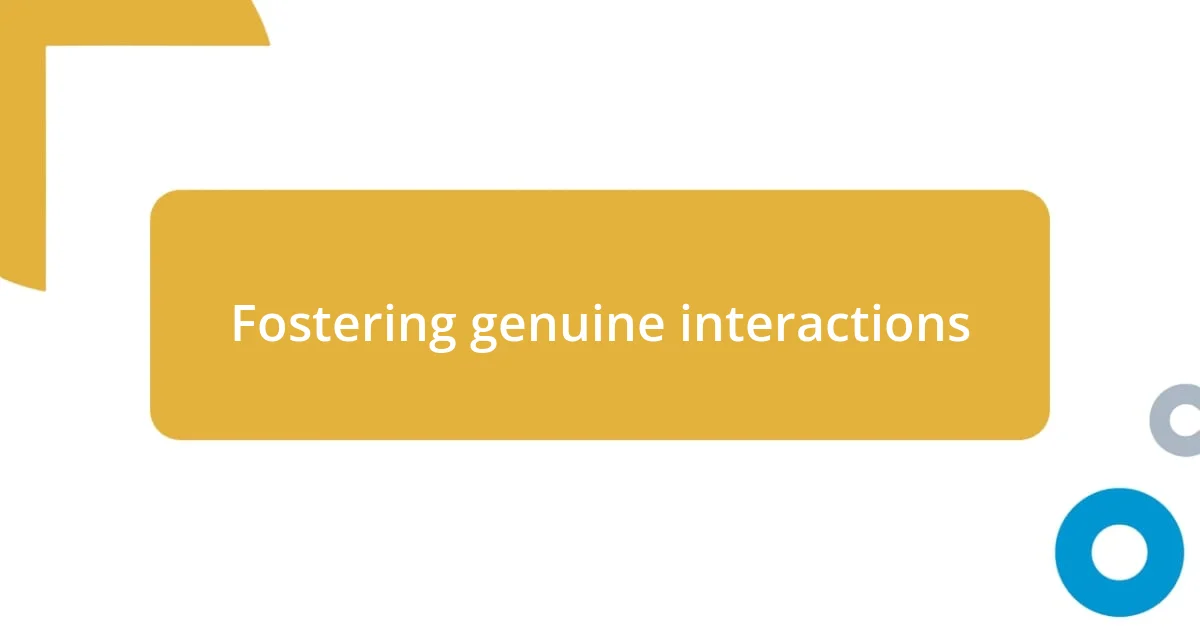
Fostering genuine interactions
To foster genuine interactions in my community, I’ve found that being approachable is crucial. I remember one event where I deliberately set aside my role as the organizer to simply mingle with everyone. During that casual conversation over coffee, a member opened up about her struggles, and instead of giving advice, I just listened. That moment reminded me how genuine connections are often born from simply being present and showing real interest in other people’s stories.
Creating spaces for open dialogue has also been pivotal. I initiated a weekly “Open Mic” night where everyone could share their thoughts, ideas, or even their frustrations. What surprised me was how participants began to support each other, offering advice or just a kind word. Have you ever experienced that feeling of camaraderie when someone understands your struggles? It’s powerful, and watching those bonds form in real time has been incredibly rewarding.
Lastly, acknowledging contributions and celebrating milestones encourages authenticity. Whenever someone shares a creative project or achieves a goal, I make it a point to highlight and celebrate their success publicly. It’s not just about recognition; it’s about reinforcing the idea that every voice matters. Do you notice how recognition brings people closer together? It not only fortifies connections but also cultivates an atmosphere where everyone feels valued and empowered to participate.
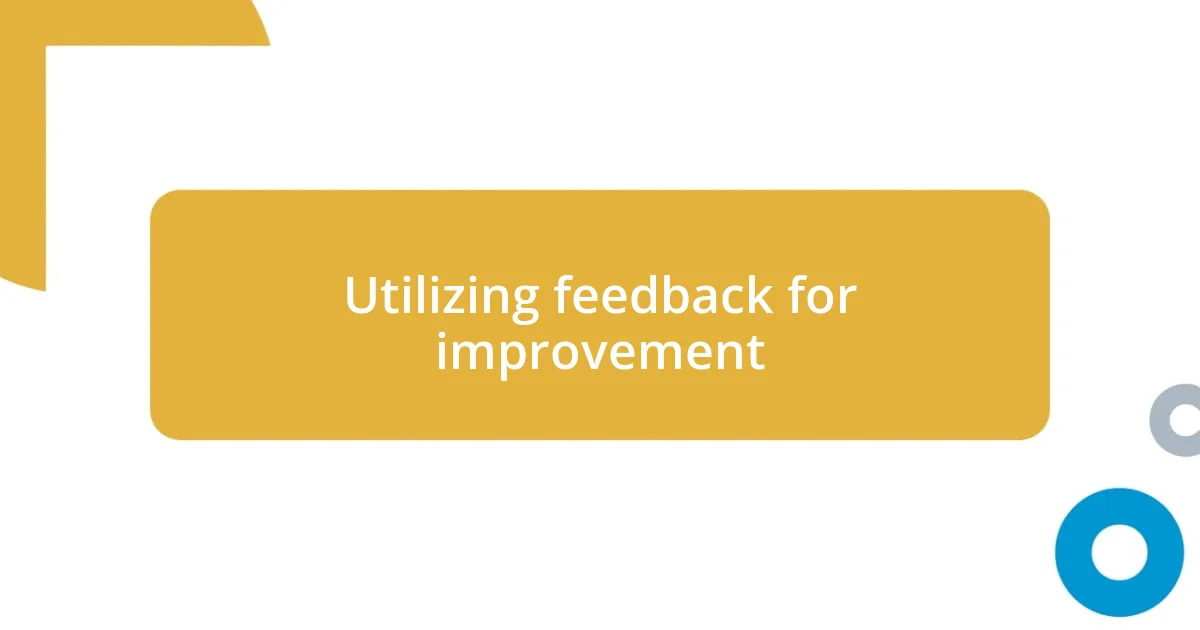
Utilizing feedback for improvement
Utilizing feedback is one of the most insightful ways to improve any community, and I’ve seen firsthand how important it can be. After hosting a month-long challenge, I sent out a survey asking participants about their experience. The responses revealed that while everyone enjoyed the concept, many wanted more guidance on getting started. This feedback helped me create a more structured approach for the next challenge, turning it into a better experience for everyone involved. Who knew that a simple survey could turn feedback into actionable change?
In my journey, I also learned to see criticism not as a setback but as an opportunity. I remember one particularly blunt comment suggesting that my content was “too technical.” Initially, it stung a bit; however, I took it to heart. It pushed me to simplify the language I used, making my ideas more accessible. As a result, not only did I engage more people, but I also fostered a deeper sense of belonging since everyone could understand and share in the conversation. Isn’t it interesting how something that feels negative at first can lead to positive growth?
Moreover, I actively encourage community members to provide ongoing feedback. During a recent live stream, I included a chat feature that allowed viewers to share their thoughts in real time. This led to a dynamic discussion, where suggestions flowed freely, and I was able to adapt the content on the fly. The energy in the room shifted, and it became a collaborative experience, rather than a one-way presentation. Have you ever participated in something that felt truly co-created? It’s such a rewarding feeling to see your audience actively shaping the direction of the conversation.
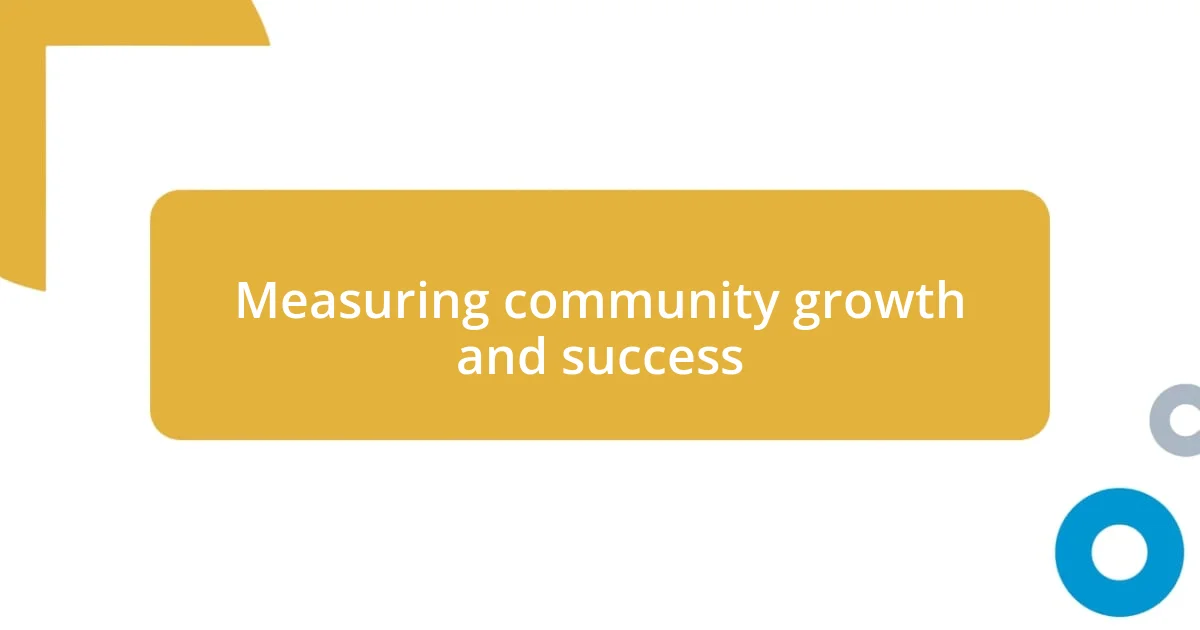
Measuring community growth and success
Measuring community growth and success is essential in understanding the health of your network. I remember when I first started assessing growth metrics. I tracked engagement through simple metrics like event participation and social media interactions. At first, the numbers seemed daunting, but as I dove deeper, I saw clear trends emerging that helped me understand what resonated with my community. Have you ever felt overwhelmed by data, only to find clarity in the patterns?
I also learned the importance of qualitative feedback alongside quantitative metrics. During one event, I implemented a ‘feelings board’ where members could anonymously express their emotions about the community. The responses were eye-opening. Seeing how members felt connected yet craved more intimate interactions made me realize that numbers alone can’t capture the full picture. I felt a sense of responsibility to nurture those emotional needs. Isn’t it fascinating how a simple board can unveil such profound insights?
Ultimately, I found that community success isn’t just about increasing numbers; it’s about creating lasting relationships. For instance, after the first year, I invited long-term members to share their experiences with newer members. These stories about personal growth sparked genuine connections and reminded everyone that success is more about the journey than the size of the group. Have you ever shared your story and seen others light up with recognition? That moment was the true measure of success for my community.
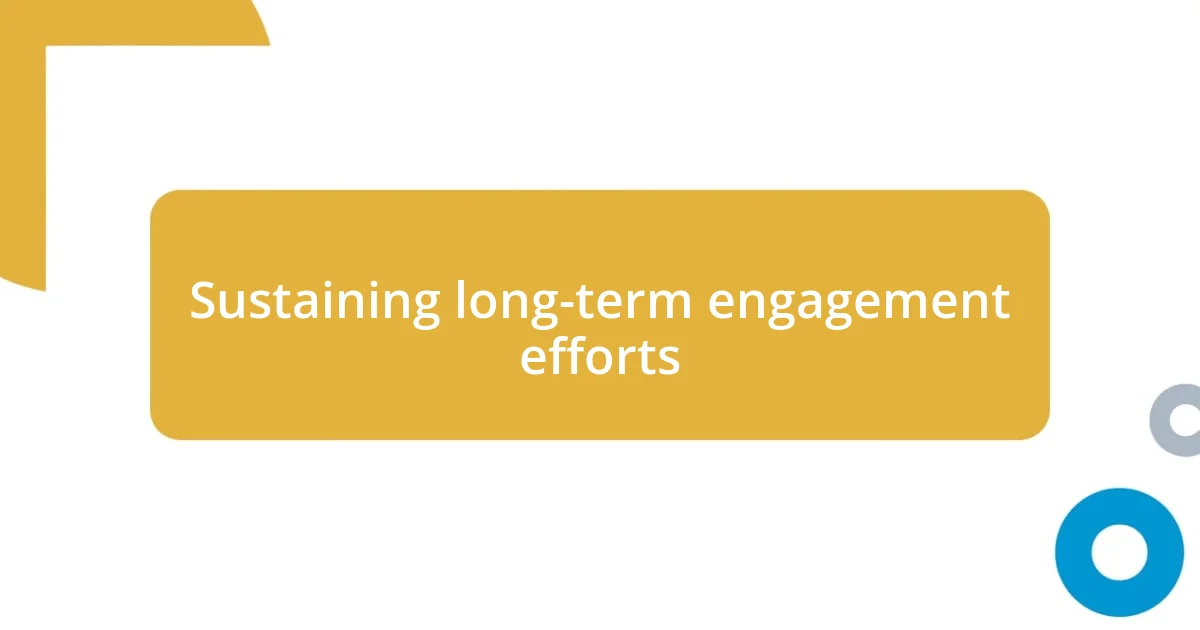
Sustaining long-term engagement efforts
To sustain long-term engagement efforts, I’ve found that consistency is key. In my experience, regularly scheduled content not only sets expectations but also creates a rhythm for the community. For instance, I implemented a monthly theme that connected various discussions. This made it easier for members to engage and look forward to what was coming next. Have you ever noticed how a familiar routine can foster deeper relationships?
Another important aspect is personalizing interactions. I make it a point to remember details about my community members, like their interests or past contributions. I can still recall how thrilled a member was when I mentioned their recent project during a community call. It’s these small gestures that show genuine care, reinforcing loyalty over time. Isn’t it wonderful how a little acknowledgment can make someone feel valued and heard?
Lastly, I’ve learned that celebrating milestones plays a significant role. Whether it’s recognizing anniversaries or achievements, taking the time to highlight these moments cultivates a sense of belonging. During a milestone celebration for our community, I was genuinely moved by how connected everyone felt. It was a reminder that our journey is not just about individual progress but about collective experiences. Have you ever paused to celebrate a small achievement and felt the joy ripple throughout your network? It truly amplifies the sense of community.

